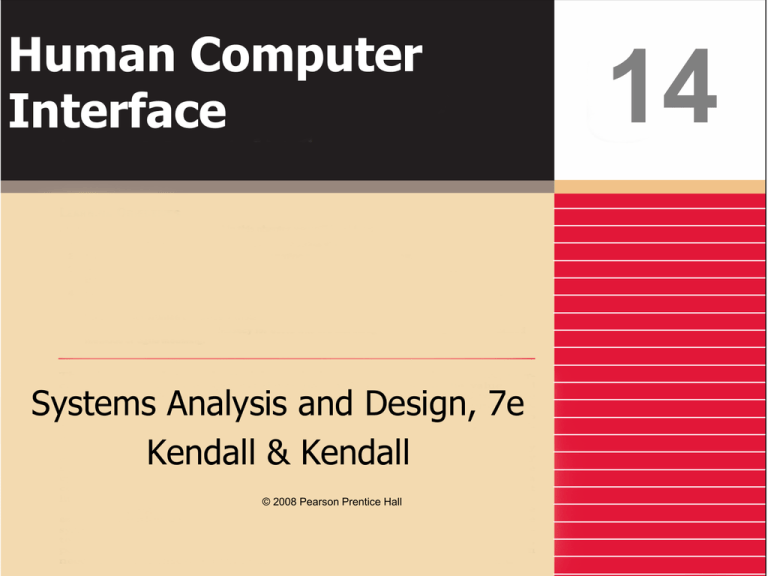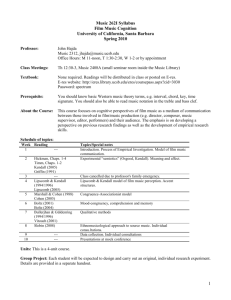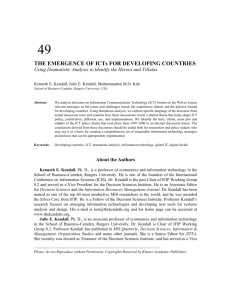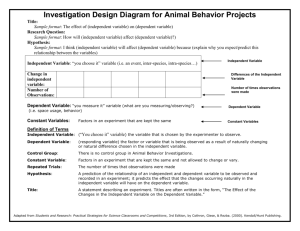
Human Computer
Interface
Systems Analysis and Design, 7e
Kendall & Kendall
© 2008 Pearson Prentice Hall
14
Learning Objectives
• Understand human-computer interaction
• Know how fit affects performance and wellbeing
• Understand the technology acceptance model
(TAM) and usability
• Know how to design for individuals and
persons with disabilities
• Understand the different types of, and
reasons for, using alternative user interfaces
Kendall & Kendall
14-2
Learning Objectives (Continued)
• Design effective dialog for HCI
• Understand the importance of user
feedback
• Articulate HCI implications for designing
ecommerce Web sites
• Formulate queries that permit users to
search the Web
Kendall & Kendall
14-3
Human-Computer Interaction
• Awareness of HCI
• Attentiveness to issues of HCI
• Existence of HCI in organizational
settings
• Need to master the concepts
surrounding HCI
• Guidelines for usability
Kendall & Kendall
14-4
Major Topics
•
•
•
•
•
•
•
•
•
Understanding human-computer interaction
Fit
TAM
Designing for cognitive styles of individual users
Physical considerations in HCI design
User interfaces
Dialog design
Feedback
Queries
Kendall & Kendall
14-5
Understanding Human-Computer
Interaction
• Knowledge about the interplay among
users, tasks, task contexts, IT, and the
environments in which the systems are
used comprises the basis of humancomputer interaction
Kendall & Kendall
14-6
Fit
• The “fit” between the HCI elements of
the human, the computer, and the task
that needs to be performed leads to
performance and well-being
Kendall & Kendall
14-7
Figure 14.1 The “fit” among the human,
computer, and task affects performance and
well-being
Kendall & Kendall
14-8
Task
• Complex tasks that require human,
system, and task interaction are
supported by ecommerce and Web
systems, ERP systems, and wireless
systems inside and outside of the
organization
• Can be structured and routine or illdefined and without apparent structure
Kendall & Kendall
14-9
Performance
• A combination of the efficiency involved
in performing a task and the quality of
the work that is produced by the task
Kendall & Kendall
14-10
Well-Being
• Concern for a human’s overall comfort,
safety, and health
• Psychological attitudes are also
important
Kendall & Kendall
14-11
The Technology Acceptance
Model (TAM) and Attitude
• A way for analysts to organize their thinking
about whether users will accept and use
information technology
• Can be used to shape training after a system
has been developed
• Can be used to garner user reactions to
prototypes
• Examines perceived usefulness and perceived
ease of use
Kendall & Kendall
14-12
The Technology Acceptance Model
(TAM) and Attitude (Continued)
• Attitudes
•
•
•
•
Kendall & Kendall
Satisfaction
Anxiety
Enjoyment
Playfulness
14-13
Usability
• A way for designers to evaluate the
systems and interfaces they create with
an eye toward addressing as many HCI
concerns as thoroughly possible
• Usability standards
• Usability heuristics
Kendall & Kendall
14-14
Designing for Cognitive Styles of
Individual Users
• Making sure data is made available in
different forms
•
•
•
•
Kendall & Kendall
Tables
Graphs
Text
Different times
14-15
Pivot Tables
• Allows a user to arrange data in a table
in any way they choose
• Gives users greater control over how
they look at data in different ways
within a table
Kendall & Kendall
14-16
Figure 14.3 A pivot table template can make it easier
for users to see information displayed in different ways
Kendall & Kendall
14-17
Visual Analysis of Databases
• Support visual thinking
• Extend the user’s cognitive capabilities
• Increase the changes of making an
appropriate decision
Kendall & Kendall
14-18
Figure 14.7 When different graphs or tables can be
displayed on the same page, the page resembles a
dashboard. (Courtesy of www.tableausoftware.com.)
Kendall & Kendall
14-19
Physical Considerations in HCI
Design
• Vision
• Hearing
• Touch
Kendall & Kendall
14-20
Considering Human Limitations,
Disabilities, and Design
• An individual with a disability is a
person who:
• Has a physical or mental impairment that
substantially limits one or more major life
activities
• Has a record of such impairment, or
• Is regarded as having such an impairment
Kendall & Kendall
14-21
Figure 14.8 The HCI approach to systems design
emphasizes the fit among the human, computer, and
task
Kendall & Kendall
14-22
Interface Design Objectives
•
•
•
•
•
Match the user interface to the task
Make the user interface efficient
Provide appropriate feedback to users
Generate usable queries
Improve productivity of computer users
Kendall & Kendall
14-23
Types of User Interfaces
•
•
•
•
•
•
•
Natural-language interfaces
Question-and-answer interfaces
Menus
Form-fill interfaces
Command-language interfaces
Graphical User Interfaces (GUIs)
Web interfaces
Kendall & Kendall
14-24
Natural-Language Interfaces
• Permit users to interact with the
computer in their everyday or "natural"
language
• Implementation problems and
extraordinary demand on computing
resources have so far kept naturallanguage interfaces to a minimum
Kendall & Kendall
14-25
Question-and-Answer
Interfaces
• The computer displays a question to the
user on the display
• The user enters an answer
• The computer acts on that input
information in a preprogrammed manner
• Users unfamiliar with applications may find
question-and-answer interfaces most
comfortable
Kendall & Kendall
14-26
Menus
• Provides the user with an onscreen list of
available selections
• Not hardware dependent
• Can be put aside until the user wants to use
them
• Can be nested within one another to lead a
user through options in a program
• GUI menus
• Object menu
Kendall & Kendall
14-27
Form-Fill Interfaces (Input/Output
Forms)
• Onscreen forms or Web-based forms
displaying fields containing data items or
parameters that need to be communicated to
the user
• Advantage
• The filled-in form provides excellent
documentation
• Disadvantage
• Users experienced with the system or application
may become impatient
Kendall & Kendall
14-28
Figure 14.12 An example of the form-fill
interface from Form Flow by Jetform
Kendall & Kendall
14-29
Command-Language
Interfaces
• Allows the user to control the application with
a series of keystrokes, commands, phrases,
or some sequence of these
• Affords the user more flexibility and control
• Require memorization of syntax rules
• May be an obstacle for inexperienced users
Kendall & Kendall
14-30
Figure 14.13 Commandlanguage interface
Kendall & Kendall
14-31
Graphical User Interfaces
• Provide users constant feedback on task
accomplishment
• An appropriate model of reality or an
acceptable conceptual model of the
representation must be invented
Kendall & Kendall
14-32
Other User Interfaces
• Pointing devices
• Touch-sensitive screens
• Speech recognition and synthesis
Kendall & Kendall
14-33
Speech Recognition and Synthesis
• The user speaks to the computer, and
the system is able to recognize an
individual’s vocal signals, convert them,
and store the input
• Continuous speech systems
• Speaker independence
Kendall & Kendall
14-34
Figure 14.14 Using software such as Dragon NaturallySpeaking by
Nuance, a user can speak commands to their computer. In this
example, the user corrects a word by pulling up a menu of
alternative words that sound the same
Kendall & Kendall
14-35
Evaluating Interfaces
• Training period for users should be acceptably short
• Users early in their training should be able to enter
commands without thinking about them, or referring
to a help menu or manual
• The interface should be seamless so that errors are
few, and those that do occur are not occurring
because of poor design
• Time that users and the system need to bounce back
from errors should be short
• Infrequent users should be able to relearn the system
quickly
Kendall & Kendall
14-36
Guidelines for Dialog Design
• Meaningful communication
• Minimal user action
• Standard operation and consistency
Kendall & Kendall
14-37
Meaningful Communication
• The system should present information
clearly to the user
• Users with less skill with a computer
require more communication
• Easy to use help screens
Kendall & Kendall
14-38
Minimal User Action
• Keying codes instead of whole words
• Entering data that are not already stored on
files
• Supplying the editing characters
• Using default values for fields on entry
screens
• Designing an inquiry, change, or delete
program so that the user needs to enter only
the first few characters of a name or item
description
Kendall & Kendall
14-39
Minimal User Action (Continued)
• Providing keystrokes for selecting pull-down
menu options
• Use radio buttons and drop-down lists to
control displays of new Web pages or to
change Web forms
• Provide cursor control for Web forms and
other displays so the cursor moves to the
next field when the right number of
characters has been entered
Kendall & Kendall
14-40
Standard Operation and
Consistency
• Locating titles, date, time, and operator and
feedback messages in the same places on all
displays
• Exiting each program by the same key or
menu option
• Canceling a transaction in a consistent way
• Obtaining help in a standardized way
• Standardizing the colors used for all displays
or Web pages
Kendall & Kendall
14-41
Standard Operation and
Consistency (Continued)
• Standardizing the use of icons for similar
operations when using graphical user
interface
• Using consistent terminology in a display or
Web site
• Providing a consistent way to navigate
through the dialog
• Using consistent font alignment, size, and
color on a Web page
Kendall & Kendall
14-42
Figure 14.16 This tab control dialog box has seven
tabs. The chosen tab “Paper” appears as if it is in front
of the other tabs
Kendall & Kendall
14-43
Feedback for Users
• All systems require feedback to monitor
and change behavior
• Feedback compares current behavior
with predetermined goals and gives
back information describing the gap
between actual and intended
performance
Kendall & Kendall
14-44
Types of Feedback
•
•
•
•
•
•
•
Acknowledging acceptance of input
Recognizing that input is in the correct form
Notifying that input is not in the correct form
Explaining a delay in processing
Acknowledging that a request is completed
Notifying that a request was not completed
Offering the user more detailed feedback
Kendall & Kendall
14-45
Including Feedback in Design
• Can be a powerful reinforcer of users’
learning processes
• Serve to improve user performance with
the system
• Increase their motivation to produce
• Improve the fit among the user, task
and the technology
Kendall & Kendall
14-46
A Variety of Help Options
•
•
•
•
•
•
•
Pressing a function key, such as F1
A GUI pull-down menu
Context-sensitive help
Icon tips
Wizards
Online help or help lines
Software forums
Kendall & Kendall
14-47
Special Design Considerations for
Ecommerce
• Soliciting feedback from ecommerce
Web site customers
• Easy navigation for ecommerce Web
sites
• Can readily return to the Web site
Kendall & Kendall
14-48
Soliciting Feedback from
Ecommerce Web Site Customers
• Launch the user’s email program
• Take users to a blank message
template when they click on “feedback”
Kendall & Kendall
14-49
Easy Navigation for Ecommerce
Web Sites (One-Click Navigation)
• Creating a rollover menu
• Building a collection of hierarchical links
• Placing a site map on the home page
and emphasizing the link to it
• Placing a navigational bar on every
inside page that repeats the categories
used on the entry screen
Kendall & Kendall
14-50
Easy Navigation for Ecommerce Web
Sites (Other Considerations)
• Search function
• Creating flexibility
• Creating for users with different
cognitive processing , or interests
• Keeping the customers on the Web site
Kendall & Kendall
14-51
Designing Queries
• Help reduce users’ time spend in
querying the database
• Help them find the data they want
• Result in a smoother user experience
overall
Kendall & Kendall
14-52
Query Types
• Query Type 1
• What is the value of a specified attribute for a
particular entity
• Query Type 2
• What entity has a specified value for a particular
attribute
• Query Type 3
• What attribute(s) has (have) a specified value for
a particular entity
Kendall & Kendall
14-53
Query Types (Continued)
• Query Type 4
• List all the values for all the attributes for a
particular entity
• Query Type 5
• List all entities that have a specified value for all
attributes
• Query Type 6
• List all the attributes that have a specified value
for all entities
Kendall & Kendall
14-54
Figure 14.21 It is possible to perform six basic types of
queries on a table that contains entities, attributes, and
values
Kendall & Kendall
14-55
Query Notation
V is value, E is entity, A is attributes,
variables in parentheses are given:
•
•
•
•
•
•
Kendall & Kendall
Query
Query
Query
Query
Query
Query
type
type
type
type
type
type
1:
2:
3:
4:
5:
6:
V (E, A)
E (V, A)
A (V, E)
all V (E, all A)
all E (V, all A)
all A (V, all E)
14-56
Building More Complex Queries
• Arithmetic operations are performed first
• Exponentiation
• Either multiplication or division
• Addition or subtraction
• Comparative operations are performed
• GT, LT , and others
• Boolean operations are performed
• First AND and then OR
Kendall & Kendall
14-57
Query Methods
• Query By Example (QBE), the database fields
are selected and displayed in a grid, and
requested query values are either entered in
the field area or below the field
• Structured Query Language (SQL), uses a
series of words and commands to select the
rows and columns that should be displayed in
the resulting table
Kendall & Kendall
14-58
Figure 14.23 Query by example
using Microsoft access
Kendall & Kendall
14-59
Figure 14.26 Structured Query Language (SQL) for the
CUSTOMER NAME parameter query
Kendall & Kendall
14-60
Summary
• Human-computer interaction (HCI)
• User interfaces
• TAM
• Usability
• HCI approach
Kendall & Kendall
14-61
Summary (Continued)
• Designing the user interface
•
•
•
•
•
•
•
•
•
•
Kendall & Kendall
Natural language
Question and answer
Menus
Form-fill and Web-based form-fill
Graphical user interfaces
The mouse
Lightpens
The stylus
Touch-sensitive screens
Voice recognition systems
14-62
Summary (Continued)
• Designing user feedback
• Let users know if their input is being
accepted
• If input is or is not in the correct form
• If processing is going on
• If requests can or cannot be processed
• If more detailed information is available
and how to get it
Kendall & Kendall
14-63
Summary (Continued)
• Designing ecommerce Web site
feedback
•
•
•
•
Rollover menus
Hierarchical displays of links
Site maps
Navigation bars
• Queries
• Six basic types
Kendall & Kendall
14-64







